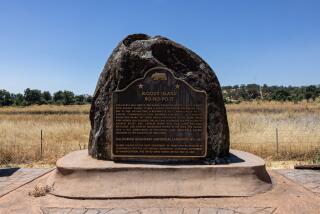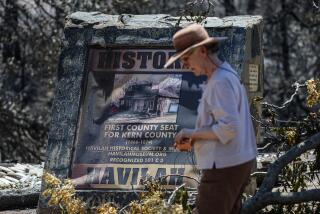A Hard-Bitten Place Named After Jim
It owes its name to a saloonkeeper and never has offered its residents a whole lot more than hard work and a hard time. But the tiny tract called Jimtown in the Whittier area is not only one of Los Angeles Countyâs oldest continuously inhabited communities, but also the most enduring legacy of Californiaâs last Mexican governor, Pio Pico.
It began in the mid-19th century as a primitive labor camp for Native Americans on the banks of the San Gabriel River, where a scattering of thatched huts, playing children and drying fish created a postcard scene of life in Old California.
In the 1860s, the site became part of the former governorâs 9,000-acre spread, formally known as Rancho Paso de Bartolo Viejo and informally as El Ranchito or Picoville. Soon the Native Americans were joined by poor Mexican immigrants, and the camp was on its way to becoming a rough-and-tumble town of mud and wood hovels for those at the bottom of the farm labor pool.
*
Pico built a chapel north of his mansion, and soon an adobe saloon went up not far away. The patron fed, sheltered and gave work to the willing, while questionable characters hid out in the dense growth of vines and cottonwoods along the riverbank. It was a lively place where horse races, cockfights and dances were the usual entertainment. Fights were frequent, and the community soon attracted the attention of the new American authorities in nearby Los Angeles.
In those days, the cityâs Anglo elite forced its will on minorities through the Monte Boys, Texas and Tennessee squatters from the âislandâ of El Monte, who were allowed to deliver vigilante âjusticeâ to the regionâs Indians, Chinese and Mexican Americans.
Meting out their punishment at the end of a rope, the Monte Boys hung a shoe thief from a tree near the riverbank in Picoville.
In September 1883, Ranulfo, one of Picoâs two sons by his mistress, Felicia Romero, was shot and killed over a young girl at a dance in the saloon.
Less than a decade later, Pico became a victim of a real estate scam and lost his storied ranch. A local political heavyweight named Jim Harvey stepped in and bought a 22-acre slice of the property bounded by the San Gabriel River, Whittier and Beverly boulevards and a natural cliff formation to the east near Whittier.
Harvey was a constant source of scandal to the strait-laced Quakers who had settled next door in Whittier. But, by the turn of the century, he had subdivided his land as more Mexican families trekked north in hopes of nurturing their version of the American dream.
The landownerâs rollicking bar became a way station for immigrants, who harvested crops and picked fruit during the day, and could drown their sorrows at night. Whenever they found the time, they patched together a shantytown of 250 clapboard homes on rutted dirt streets, with no lights or sewers. Floods from the river were as much a fact of life as the suspicions of the barrioâs Anglo neighbors.
The saloonâs loyal patrons began calling the community Jimâs Town, then Jim Town and finally Jimtown.
Tony Bueno, a Jimtown-born lawyer whose grandparents moved to the isolated barrio in the early 1920s and opened a Mexican restaurant, recalls that in those days, there were no door-to-door mail deliveries, no street lights, only one paved road and many outhouses.
âMail was dumped into a large box at the corner grocery store, and trash was picked up by a harmless giant of a man named Boots, who owned a pigsty near the river. He pulled a cart carrying two 50-gallon drums that he filled with neighborsâ garbage,â Bueno recalled.
Mothers sometimes called upon Boots to help discipline their children, because his overwhelming size and stench frightened them. He would pick up the trembling child, hold him over the barrel of garbage and threaten to drop him inside if he didnât promise to be good.
*
Jimtown always packed a punch. On a vacant lot, residents put up a makeshift wooden stage for boxing matches that were followed by dancing on the bloodstained platform. Barrio youngsters idolized boxing champ Bert Colima, who would visit the communityâs ballpark, fielding questions and handing out advice.
âDuring World War II, there was a lot of patriotism in Jimtown,â said Bueno, who had polio as a youngster and was unable to join the Army. âFamilies placed flags with stars on them in their windows. Each star represented a son serving his country. Some families had three or more stars. For a few extra bucks, servicemen on leave would come home and sell their military uniforms to barrio kids, then later have new ones reissued.â
When the Union Pacific tracks were laid next to the San Gabriel River in the 1940s, many families living in the riverbed area were displaced.
But Jimtown--which fluctuated in population between 900 and 1,200--was hit hardest in 1955, when transportation authorities making way for the 605 Freeway began leveling the tiny wood-frame buildings, including the saloon that had survived a century as a working manâs watering hole.
*
The families who remained in the primarily Spanish-speaking neighborhood were put on notice to clean up or tear down their houses. Eager to spruce up their communityâs image, they began making improvements to the 60 or so homes that remained.
Volunteers went to work in the late 1960s, donating material and laying claim to a strip of vacant land on seven acres north of the residential area. Over the years the barren stretch took on the appearance of a rough-hewn park.
Finally, in 1985, their labor paid off when Los Angeles County bought the site as surplus property from the state and helped turn it into what is now Amigos Park.
Today, Jimtown remains a place apart. It has no government of its own, no city hall, not even a sign to announce its presence. And where Pio Picoâs farmhands refreshed themselves and Jim Harvey kept his saloon, there is a kind of working manâs memorial: the Whittier Boulevard offramp of the freeway.
More to Read
Sign up for Essential California
The most important California stories and recommendations in your inbox every morning.
You may occasionally receive promotional content from the Los Angeles Times.










